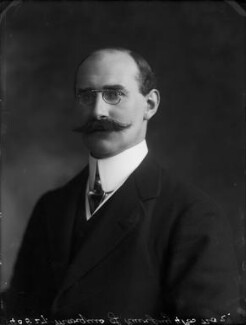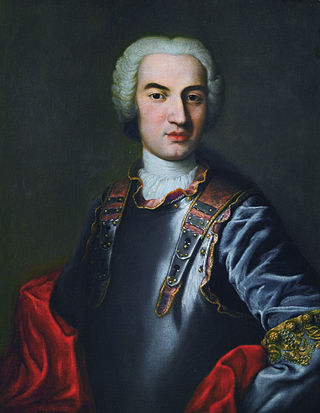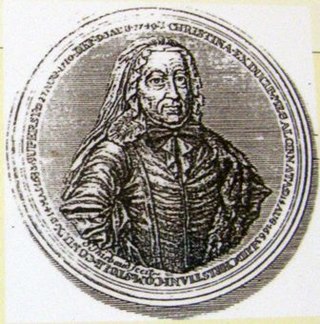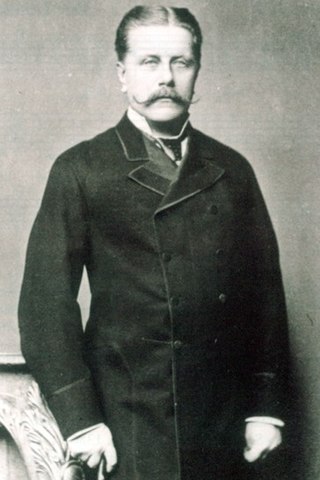Related Research Articles

Prince Karl Theodor Maximilian August of Bavaria ; and grand prior of the order of Malta, was a Bavarian soldier.

Princess Adelaide Louise of Schleswig-Holstein-Sonderburg-Glücksburg was a daughter of Friedrich Ferdinand, Duke of Schleswig-Holstein and his wife Princess Karoline Mathilde of Schleswig-Holstein-Sonderburg-Augustenburg.

Baroness Caroline von Spiering, Countess von Holnstein, Baroness von Künsberg was a German noblewoman, best known for her appearance in the Gallery of Beauties.

Melville Amadeus Henry Douglas Heddle de la Caillemotte de Massue de Ruvigny was a British genealogist and author who was twice president of the Legitimist Jacobite League of Great Britain and Ireland. He styled himself the Marquis of Ruvigny and Raineval.

Otto Grafzu Stolberg-Wernigerode was an Imperial German officer, diplomat and politician who served as the first vice-chancellor of the German Empire under Otto Von Bismarck between 1878 and 1881.

Prince William of Schaumburg-Lippe was son of George William, Prince of Schaumburg-Lippe and member of the House of Lippe.

Karl Christian Erdmann of Württemberg-Oels was ruling duke of Württemberg-Oels and Bernstadt.

The House of Stolberg is the name of an old and large German dynasty of the former Holy Roman Empire's high aristocracy. Members of the family held the title of Fürst and Graf. They played a significant role in feudal Germany's history and, as a mediatized dynasty, enjoyed princely privileges until the collapse of the German Empire in 1918. The house has numerous branches.
Prince Charles Ferdinand William of Solms-Lich-Hohensolms was a German politician. He was president of the First Chamber of the Estates of the Grand Duchy of Hesse. His sister, Princess Eleonore of Solms-Hohensolms-Lich married Ernest Louis, Grand Duke of Hesse

Countess Elisabeth of Nassau-Siegen, German: Elisabeth Gräfin von Nassau-Siegen, official titles: Gräfin zu Nassau, Vianden und Diez, was a countess from the House of Nassau-Siegen, a cadet branch of the Ottonian Line of the House of Nassau, and through marriage Countess of Wied.

Princess Maria of Hanau and Hořowitz was a German aristocrat.

Christine of Mecklenburg-Güstrow was a German noblewoman of the House of Mecklenburg and by marriage Countess of Stolberg-Gedern.

William of Hesse-Philippsthal-Barchfeld, was a German prince of the Hesse-Philippsthal-Barchfeld branch of the House of Hesse, and Konteradmiral of the Prussian and Imperial German Navy.

Holnstein is part of the community of Neukirchen bei Sulzbach-Rosenberg. It is located in Bavaria, Germany.

Marie, Duchess of Ratibor, Princess of Corvey, Princess of Hohenlohe-Schillingsfürst was an Austrian aristocrat and consort of Victor II, the last reigning Duke of Ratibor and Prince of Corvey.

Ferdinand Maximilian III of Ysenburg-Wächtersbach was the head of the Wächtersbach branch of the House of Ysenburg and the first Prince of Isenburg-Budingen-Wächtersbach.

Maximilian Carl Theodor, Count von Holnstein aus Bayern was a German nobleman who was a playmate of princes Ludwig and Otto, and friend of Ludwig on his accession as Ludwig II. Count Maximilian brought Ludwig's "Kaiserbrief" to Otto von Bismarck.
Friedrich August Ludwig, Graf von Bismarck was a German lawyer and Member of Parliament.
Karl Heinrich Alban, Count of Schönburg-Forderglaucha was the head of the mediatised German Counts of Schönburg-Glauchau from 1815 until his death in 1864.

Friedrich Wilhelm von Hanau-Hořowitz was a German aristocrat.
References
- ↑ Solms-Laubach, Rudolph zu (1865). Geschichte des Grafen- und Fürstenhauses Solms (in German). Adelmann.
- ↑ Raineval, Melville Henry Massue marquis de Ruvigny et; Raineval, Melville Henry Massue Marquis of Ruvigny and (1914). The Titled Nobility of Europe: An International Peerage, Or "Who's Who," of the Sovereigns, Princes, and Nobles of Europe. Burke's Peerage. p. 1371. ISBN 978-0-85011-028-9.
- ↑ "Hessian Biography : Extended Search : LAGIS Hessen". www.lagis-hessen.de. Retrieved 2022-08-06.
- ↑ Ein goldener Schimmer aus fernen Zeiten. Die Schlossbibliothek zu Laubach lädt mit einer Ausstellung in alte Gärten ein [In:] Unseroberhessen, 88. Jahrgang, 2/2012, S. 20–21.
- ↑ Michael Sachs: Die Flucht der evangelischen Frau Anna Magdalena von Reibnitz (1664–~1745) mit ihren von der Zwangskatholisierung bedrohten fünf Kindern aus Schlesien im Jahre 1703 – ein Stimmungsbild aus dem Zeitalter der Gegenreformation und des Pietismus. In: Medizinhistorische Mitteilungen. Zeitschrift für Wissenschaftsgeschichte und Fachprosaforschung. Band 34, 2015 (2016), S. 221–263, hier: S. 227.
This article needs additional or more specific categories .(October 2022) |